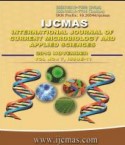


 National Academy of Agricultural Sciences (NAAS)
National Academy of Agricultural Sciences (NAAS)

|
PRINT ISSN : 2319-7692
Online ISSN : 2319-7706 Issues : 12 per year Publisher : Excellent Publishers Email : editorijcmas@gmail.com / submit@ijcmas.com Editor-in-chief: Dr.M.Prakash Index Copernicus ICV 2018: 95.39 NAAS RATING 2020: 5.38 |
Weather is the major threats for wheat production in South East Asia region and highly influenced by the environmental conditions, sowing date, nature of genotypes and growth stages of wheat. Climate change is a serious concern for the food security and lively hood of small farmers as reported from all over world. A period of 30 years is decided as a period of climate change study by World Meteorological Organisation (WMO).So the period from 1985-2016 is taken for the study. Weather forecasting is very important for decision making processes in management practices applying for controlling the damage caused by climate change. The objective of present study was to develop Multiple Linear Regression (MLR), Autoregressive Integrated Moving Average (ARIMA) model, Autoregressive integrated moving average with exogenous variable (ARIMAX) model, Artificial Neural Network (ANN) models for forecasting climate change impact for Varanasi region of India. For development of models, weather indices were computed from weekly data related to maximum temperature, minimum temperature, Rainfall and Solar radiation.
 |
 |
 |
 |
 |